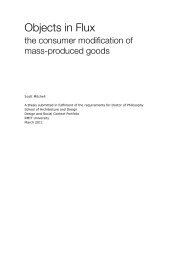Making Memory Space: Recollection and Reconciliation in Post ...
Making Memory Space: Recollection and Reconciliation in Post ...
Making Memory Space: Recollection and Reconciliation in Post ...
You also want an ePaper? Increase the reach of your titles
YUMPU automatically turns print PDFs into web optimized ePapers that Google loves.
a mechanism of power, to create new physical <strong>and</strong> ideological languages. It does not seek to explore<br />
the cognitive operations of memory, rather to exam<strong>in</strong>e <strong>and</strong> critique differ<strong>in</strong>g modes of memory space<br />
<strong>in</strong> order to better underst<strong>and</strong> the relationship between physical space <strong>and</strong> recollection <strong>and</strong> the extent<br />
to which that can be successfully controlled or designed. This study uses memory <strong>in</strong> South Africa as a<br />
spr<strong>in</strong>gboard for an analysis of the mechanisms around the production of memory <strong>and</strong> the construction<br />
of memory space. The demise of Apartheid has provided an opportunity for re-exam<strong>in</strong>ation of the<br />
status quo <strong>in</strong> a society that is seek<strong>in</strong>g to privilege memory <strong>and</strong> the process of recollection. In<br />
attempt<strong>in</strong>g to f<strong>in</strong>d an appropriate voice for South African memory space, wider implications of the<br />
mechanisms of these architectures come to light. While unique to the South African context,<br />
discussions around the successes <strong>and</strong> failures of that memory space proffer <strong>in</strong>sights <strong>in</strong>to the<br />
mach<strong>in</strong>ations of memory space at a broader level. It is my objective that <strong>in</strong> underst<strong>and</strong><strong>in</strong>g how the<br />
spatial production of memory operates <strong>in</strong> South Africa, we may draw conclusions about the<br />
possibilities <strong>and</strong> limits of architectural memory practice <strong>in</strong> other environments.<br />
The conscious manner with which South Africa addresses the past presents a unique context from<br />
which to exam<strong>in</strong>e memory <strong>and</strong> the construction of memory space. The specificity of the situation<br />
stems <strong>in</strong> part from the overarch<strong>in</strong>g trauma <strong>in</strong>herent <strong>in</strong> the existence of Apartheid itself, which impacted<br />
the county socially, politically <strong>and</strong> spatially. Apartheid spans approximately 50 years <strong>and</strong> is a historical<br />
imperative unique to South Africa. Yet arguably, its roots emerge from a previous history, one that<br />
foregrounds it <strong>in</strong> a colonial context. Thus the country has a long history of spatial appropriation that<br />
has resulted <strong>in</strong> the dom<strong>in</strong>ance of one cultural perspective over another. Dur<strong>in</strong>g the years of Apartheid,<br />
space was utilised as a tool for articulat<strong>in</strong>g the specificities of the laws of Apartheid <strong>and</strong> mak<strong>in</strong>g<br />
manifest the racial divisions. These were <strong>in</strong>culcated <strong>in</strong>to every aspect of built form. The Apartheid<br />
government formulated a deliberate policy of marg<strong>in</strong>alisation <strong>and</strong> segregation <strong>in</strong> their approach to civic<br />
space, which has widely impacted on black South Africans’ ability to relate to civic spaces <strong>and</strong> to f<strong>in</strong>d<br />
a personal connection with state architecture. 10 With<strong>in</strong> South Africa, sites of the past, both as locations<br />
where the realities of Apartheid were enacted <strong>and</strong> those that reflected selective narratives of the past<br />
(such as museums <strong>and</strong> memorials), have become politically contested ground. 11 In order for the<br />
country to move forward <strong>in</strong> a cohesive <strong>and</strong> multicultural way, the government is seek<strong>in</strong>g to address<br />
these sites <strong>and</strong> to acknowledge their place as talismans <strong>in</strong> the l<strong>and</strong>scape of Apartheid, so that the<br />
general population may beg<strong>in</strong> to come to terms with them. In other countries that have experienced<br />
regime change, Central <strong>and</strong> Eastern Europe for example, outdated symbols <strong>and</strong> monuments are re-<br />
exam<strong>in</strong>ed <strong>and</strong> often discarded <strong>in</strong> favour of politically expedient messages. 12 The challenge for post-<br />
Apartheid South Africa follow<strong>in</strong>g the elections <strong>in</strong> 1994 has been to address this endemic vision of the<br />
10<br />
Lisa F<strong>in</strong>dley, ‘Noero Wolfff Architects commemorates the struggle aga<strong>in</strong>st Apartheid at the Red Location Museum <strong>in</strong> South<br />
Africa’, Architectural Record, 03.06 (2006), p.103.<br />
11<br />
Christopher Saunders, ‘The Transformation of Heritage <strong>in</strong> the new South Africa’, <strong>in</strong> Hans Erik Stolten (ed), History <strong>Mak<strong>in</strong>g</strong> <strong>and</strong><br />
Present Day Politics: The Mean<strong>in</strong>g of Collective <strong>Memory</strong> <strong>in</strong> South Africa (Stockholm: Nordiska Afrika<strong>in</strong>stitutet Uppsala, 2007),<br />
p.183.<br />
12<br />
Mark Lewis <strong>and</strong> Laura Mulvey, Disgraced Monuments (A Monumental Pictures Production for Channel Four: New York<br />
C<strong>in</strong>ema Guild, 1993).<br />
8
















